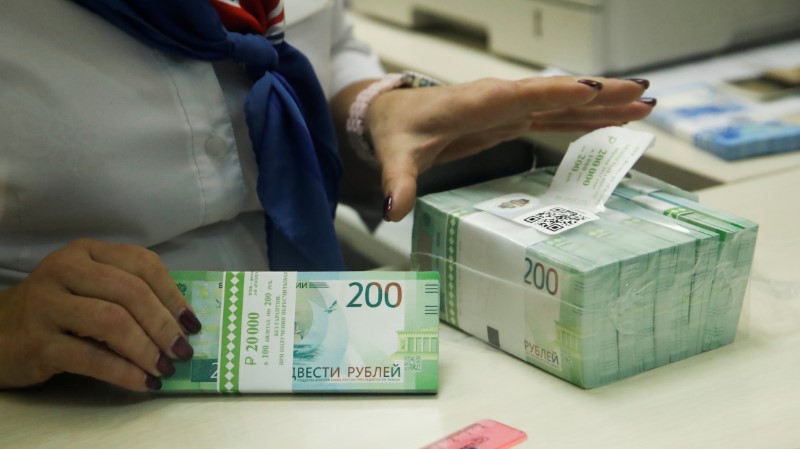 © Reuters. FILE PHOTO: A cashier holds new 200 rouble banknotes in a bank in Moscow
© Reuters. FILE PHOTO: A cashier holds new 200 rouble banknotes in a bank in MoscowBy Andrey Ostroukh
MOSCOW (Reuters) – A threat of more U.S. sanctions has sent the rouble tumbling to its weakest since mid-2016 but authorities are not expected to leap the currency’s defense after weathering a similar storm in April, analysts said.
The rouble crashed to 67.67 versus the dollar on Friday
The rouble’s slide was akin to its drop in April when, also battered by sanctions from Washington, it lost 12 percent in just a few days.
The lack of action by authorities back then is convincing market players now that they will not intervene this time either.
“When we think about what has happened in April, when sanctions were introduced and we saw a similar reaction in the rouble … this is not a move in the rouble that would make policy makers extremely worried,” said Tilmann Kolb, an emerging market analyst at UBS Global Wealth Management in London.
Liza Ermolenko, an economist at Barclays (LON:) in London, said that given the central bank refrained from intervening in the market in April, it is clear that a more sudden and deeper drop in the rouble would be required to make it step in now.
The authorities have made few public comments on the latest falls, which started on Wednesday, when the U.S. State Department announced a new round of sanctions that pushed the rouble to two-year lows and sparked a wider sell-off over fears Russia was locked in a spiral of never-ending sanctions.
On Friday the central bank said it had tools to prevent risks to financial stability, without specifying what they were.
The central bank, which last intervened in the market and raised rates to save the rouble from tanking in 2014, described the rouble’s drop on news about more U.S. sanctions as natural reaction.
As in April, the central bank has reduced its daily buying of foreign currency for state reserves this week to lift extra pressure from the rouble, which has fallen by around 15 percent versus the dollar so far this year.
“Authorities do not set a goal of avoiding a rouble drop at the moment. That’s why they won’t do anything,” said Pyotr Milovanov, currency trader at Metallinvestbank in Moscow.
Analysts say the other possible option to support the rouble would be a hike to the key interest rate, now at 7.25 percent, but this also seems to be off the table for now.
“At this stage we don’t expect policymakers to resort to rate hikes,” Ermolenko from Barclays said.
Kolb from UBS said he would “expect a bigger reaction when if we got perhaps toward 70 (roubles per dollar) but this also depends on how we get there, if at all”.
“I wouldn’t expect Russian policymakers to use their available tools to support the rouble at current levels,” he said.
Fusion Media or anyone involved with Fusion Media will not accept any liability for loss or damage as a result of reliance on the information including data, quotes, charts and buy/sell signals contained within this website. Please be fully informed regarding the risks and costs associated with trading the financial markets, it is one of the riskiest investment forms possible.
Source: Investing.com




























